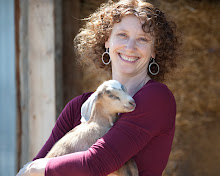
Left: view of our home from the goats’ perspective.
There was a story on NPR last night about LEED Certification—a high standard of environment-friendly features for buildings ranging from solar cells to water catchment. Different levels of LEED certification are determined through a point system—certain points for certain features, which then add up to a score, which then determines the level of certification. Anyhow, our new Farmers Market building will comply with the highest LEED Certification. While we were listening to the NPR story, my daughter asked me what the heck they were talking about. I started describing the point system, and used our own home as an example. Then it occurred to me that you all, my customers and those interested in my business, might like to know that when they support my business, they are also supporting an operation that is working on being as “green” as can be—and this might inspire some of you to make some changes to your own home and work place as well. So, although I don’t know how many points I’d accumulate under LEED standards, here are some of the green practices in place at Milk and Honey:
• Our home is passive solar. This means it is angled and designed via large windows, to gain heat when the winter sun is low in the sky, and avoid the sun in summer, when it is higher—this means certain roof angles, windows, and materials that either capture and hold the heat (winter), or maintain cool temperatures in summer. Basically in winter, we hardly heat our home during a sunny day time.
• Straw bale construction. We built a straw bale addition to our home several years ago. Our straw bale addition provides super-insulation—read more about this as a building method if you don’t know about it.
• We employ permaculture principles in our landscaping. This includes “berms and swales” to help capture water where our plants need it, and slows erosion. We pair plants together so they can provide mutual benefit—in the picture you can see the green comfrey starting to come up around the base of our fruit trees. Comfrey is a “living mulch” that keeps the tree roots cool and retains moisture, it feeds the soil with by fixing nitrogen, and it is a medicinal herb for people. This leads to another key principle of permaculture design that we try to employ—which is to choose plantings that have multiple purposes. Our plantings are watered using a drip irrigation system, as well as--
• Use of grey water irrigation. Our shower and washing machine empty into our yard—cuts down on a little long-shower guilt.
• Water catchment—horse troughs at the gutters.
• Keeping bees, is, of course, good for our environment, especially now that commercial bees are disappearing mysteriously. Bees pollinate not only food for us, but food for birds, bats, etc—they are a major part of our food chain.
• Various efficient appliances: front-loading washing machine (and a clothes line when it’s warm), low-flow toilet (actually we have a very cool toilet with two buttons to choose your water flow depending on your “deposit”), dish washer, compact fluorescent light bulbs, etc
• Low-impact, sustainably-manufactured kitchen cabinets, natural flooring (cork, Pergo, wool berber).
• In winter we heat with a charming woodstove (again, only using it in the evenings or on overcast days), and have quilted window shades on many of our windows.
• And, on order, a new Prius, hybrid car to cut down on our carbon emissions and fuel consumption as we commute to Santa Fe almost every day.
Now, there are many, many more improvements we would love to make, solar cells on the roof, and a windmill out back being just a few. We have stretched to make most of the above happen, despite the increased expense that many of these choices costs up front (the Prius being the biggest so far!!!). But of course, we feel it has been worth it. One of the biggest lifestyle/quality of life issues we are currently struggling with is our distance from Santa Fe, our time spent in the car, and the incredible waste this is creating—both in terms of time, as well as fuel. This summer we are seriously exploring a move back into Santa Fe—back to town life, where we can bike places again, and take advantage of the green benefits of living in a congested area. Goats in the city limits? I know of some goats already living there, and certainly many chickens. . . stay tuned!


